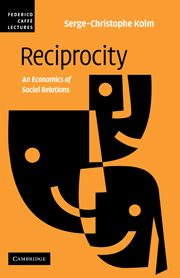Book contents
- Frontmatter
- Contents
- List of illustrations
- Foreword
- Introduction
- Part I Facts and forms
- Part II Motives
- 5 The three worlds of reciprocity
- 6 Balance reciprocity
- 7 Liking reciprocities
- 8 Other reciprocities: continuation, relational, imitation, extended
- 9 Reciprocity and social sentiments
- 10 Reciprocity in the modes of economic realization
- Part III Values and reasons
- Part IV The economics of reciprocity
- Bibliography
- Index
5 - The three worlds of reciprocity
Published online by Cambridge University Press: 22 September 2009
- Frontmatter
- Contents
- List of illustrations
- Foreword
- Introduction
- Part I Facts and forms
- Part II Motives
- 5 The three worlds of reciprocity
- 6 Balance reciprocity
- 7 Liking reciprocities
- 8 Other reciprocities: continuation, relational, imitation, extended
- 9 Reciprocity and social sentiments
- 10 Reciprocity in the modes of economic realization
- Part III Values and reasons
- Part IV The economics of reciprocity
- Bibliography
- Index
Summary
Three basic reasons
If you look attentively within yourself, or draw on your synthesis of the thousands of relevant experiences you have incurred and felt, watched and understood in others, or been told about and explained, during the decades of your life, you see that being favoured by someone – say receiving a gift – can elicit a large number of various sentiments. But you also see that providing a return gift can result only from a much smaller number of types of sentiments, albeit ones that are very different from each other (and which can be present jointly or not).
Indeed, the most important thing about reciprocity is its motives. And the most important thing about the motives of reciprocity is that they belong to three fully different classes, which can be labelled a sense of propriety, induced liking, and seeking interest. The third motive consists only in giving in return in order to elicit another gift, and, in fact, is barely worth the label “reciprocity.” The second type of motives rests on sentiments of induced mutual liking between the partners. The motives of the first type rest on a sense of social balance and include particular types of fairness. The motives of propriety or fairness and of liking have sub-motives of different kinds. The various motives and sub-motives can more or less be jointly present.
- Type
- Chapter
- Information
- ReciprocityAn Economics of Social Relations, pp. 97 - 104Publisher: Cambridge University PressPrint publication year: 2008



